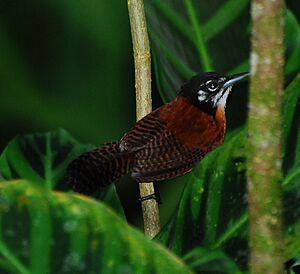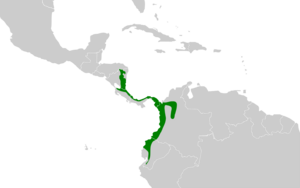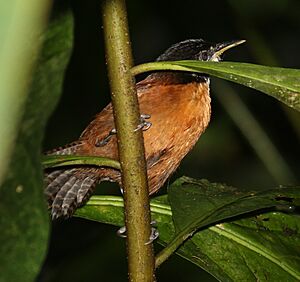Bay wren facts for kids
Quick facts for kids Bay wren |
|
|---|---|
 |
|
| In Costa Rica | |
| Conservation status | |
| Scientific classification | |
| Genus: |
Cantorchilus
|
| Species: |
nigricapillus
|
 |
|
| Synonyms | |
|
Thryothorus nigricapillus |
|
The bay wren (Cantorchilus nigricapillus) is a small bird from the Troglodytidae family, also known as wrens. These birds live in parts of southern Central America and northwestern South America. They are known for their loud, clear songs.
Contents
What is a Bay Wren?
The bay wren is a type of bird that looks a bit like other wrens. It measures about 12.6 to 15.6 centimeters (5 to 6 inches) long. It usually weighs between 17.7 and 26.3 grams (0.6 to 0.9 ounces).
Bay wrens have a black face with a thin white stripe above their eye. They also have a white spot on their cheek. Their head and neck are black, and the rest of their upper body is a rich chestnut color. Their tail is brown with bold black stripes. The throat and chest are white, turning to a reddish-brown on the lower belly. Black stripes also cross their underside. Young bay wrens look similar but have lighter colors.
Where Do Bay Wrens Live?
Bay wrens can be found from Nicaragua all the way down to Ecuador. They usually live near water, like rivers or streams. You can spot them in thick bushes, overgrown clearings, or along roadsides. They also like the lower parts of forests where there's plenty of dense plant growth.
There are seven different types, or subspecies, of bay wrens. Each subspecies lives in a specific part of the bay wren's overall range:
- C. n. costaricensis: Found from northeastern Nicaragua through Costa Rica and into western Panama.
- C. n. castaneus: Lives in west-central Panama.
- C. n. odicus: Found on Isla Escudo de Veraguas, an island off Panama's Caribbean coast.
- C. n. reditus: Lives on the Caribbean side of eastern Panama.
- C. n. schottii: Found from eastern Panama into northwestern Colombia.
- C. n. connectens: Lives in southwestern Colombia and northern Ecuador.
- C. n. nigricapillus: Found in western Ecuador.
How Do Bay Wrens Behave?
What Do Bay Wrens Eat?
Bay wrens mainly eat small creatures without backbones, like insects and spiders. They find their food by looking closely at leaves and branches. They also poke around in hanging plants and tangled vines to find hidden snacks.
How Do Bay Wrens Raise Their Young?
Bay wrens build their nests during different times of the year, depending on where they live. For example, in Costa Rica, they breed from March to October. In Panama, it's from March to November, and in Colombia, from January to August.
Their nests are often shaped like an "elbow" with a tunnel-like entrance. Some nests are more round. Both male and female wrens work together to build the nest. They use plant stems, grass, and other plant materials. They line the inside with softer fibers. A female bay wren usually lays two or three eggs.
What Do Bay Wrens Sound Like?
The song of the bay wren is very loud and clear. It's a fast series of rich, slurred whistles, trills, and warbles. Sometimes, two wrens will sing back and forth to each other. They also have many different calls they use to communicate.
Are Bay Wrens Endangered?
The IUCN (International Union for Conservation of Nature) says that the bay wren is a species of "Least Concern". This means they are not currently in danger of disappearing. They seem to do well even when humans change their habitat a little, as long as their homes aren't completely destroyed. However, scientists still need to study them more to make sure they stay safe.



